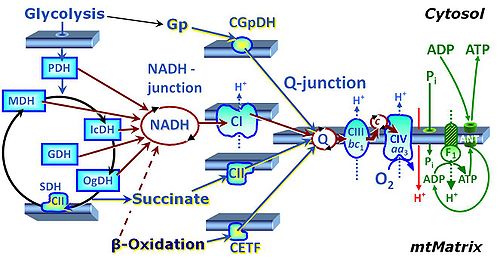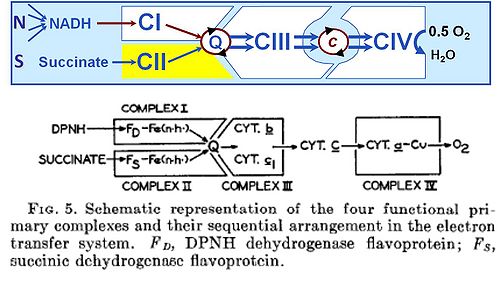Description
Respiratory Complexes are membrane-bound enzymes consisting of several subunits which are involved in energy transduction of the respiratory system. » MiPNet article
Abbreviation: CI, CII, CIII, CIV, CETF, CGpDH, ..
Reference: Gnaiger 2020 BEC MitoPathways
Respiratory Complexes - more than five

| Gnaiger E (2014) Respiratory Complexes - more than five. Mitochondr Physiol Network 2014-07-07. |
» Gnaiger 2020 BEC MitoPathways
Abstract: The 'primary respiratory Complexes' (CI to CIV) comprise the machinery for transfer of electrons from NADH and succinate to oxygen as described in an extensive series of publications by the laboratory of Hatefi (see Hatefi 1962 J Biol Chem-XLII). Complex V (CV) is the ATP synthase of the phosphorylation system, but the use of CV is discouraged (BEC 2020.1). Additional respiratory Complexes of the membrane-bound electron transfer pathway, such as CETF, CGpDH, and choline dehydrogenase, transfer electrons through the Q-junction to oxygen (Gnaiger 2009).
• O2k-Network Lab: AT Innsbruck Oroboros
Architecture of the respiratory system
The different localizations and functions of the respiratory Complexes explain the architecture of the respiratory system. Respiratory Complexes of the electron transfer pathway transfer electrons to reduce oxygen to water in aerobic respiration, whereas CV ATP synthase is part of the phosphorylation system. Proton translocation couples the electron transfer pathway to the phosphorylation system.
Membrane-spanning respiratory Complexes function as proton pumps (in most mitochondria CI, CIII, CIV and CV; in yeast mitochondria CIII, CIV and CV). Respiratory Complexes bound to one side of the inner mt-membrane and CI transfer electrons to the Q-junction which separates upstream and downstream segments of the electron transfer pathway. CETF is localized to the inner face of the mt-inner membrane, and CGpDH is a respiratory complex localized to the outer face of the mt-inner membrane.
Primary Complexes and supercomplexes
The 'primary Complexes' (CI to CIV) comprise the machinery for transfer of electrons from NADH and succinate to oxygen as described in an extensive series of publications by the laboratory of Hatefi (see Hatefi 1962 J Biol Chem-XLII). Secondary Complexes (supercomplexes) and their activities have been described to be stable at repeated freezing, thawing, dilution, centrifugation, and storage at -20 °C. The activity of supercomplexes is representative of electron transfer function in intact mitochondria activated by appropriate substrate combinations. Supercomplexes delineate very clearly the architecture of the respiratory system.
Whereas Hatefi et al described supercomplexes including CII, currently considered supercomplexes are restricted to CI, CIII and CIV (respirasome), CI and CIII, and CIII and CIV (Bianchi 2004 J Biol Chem, Lapuente-Brun 2013 Science).
References
| Bioblast link | Reference | Year |
|---|---|---|
| BEC 2020.1 doi10.26124bec2020-0001.v1 | Gnaiger E et al ― MitoEAGLE Task Group (2020) Mitochondrial physiology. Bioenerg Commun 2020.1. https://doi.org/10.26124/bec:2020-0001.v1 | 2020 |
MitoPedia methods:
Respirometry
MitoPedia topics:
Enzyme
Labels:
HRR: Theory


